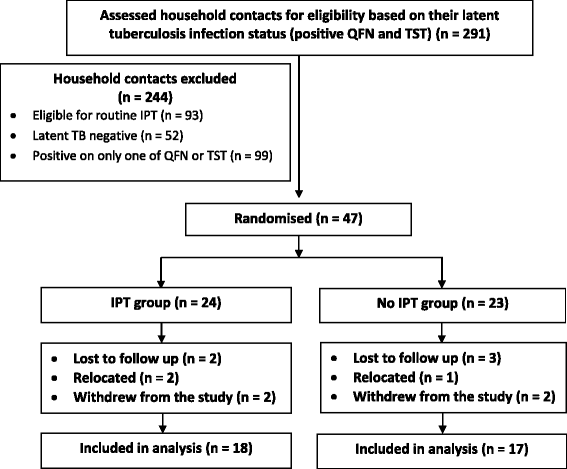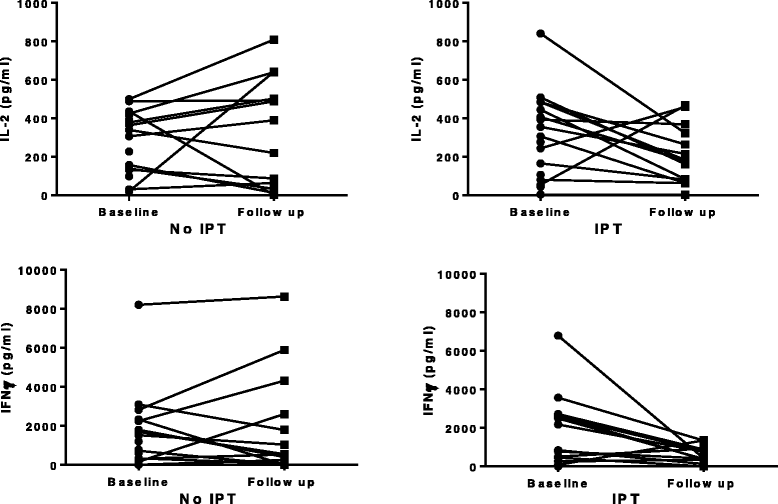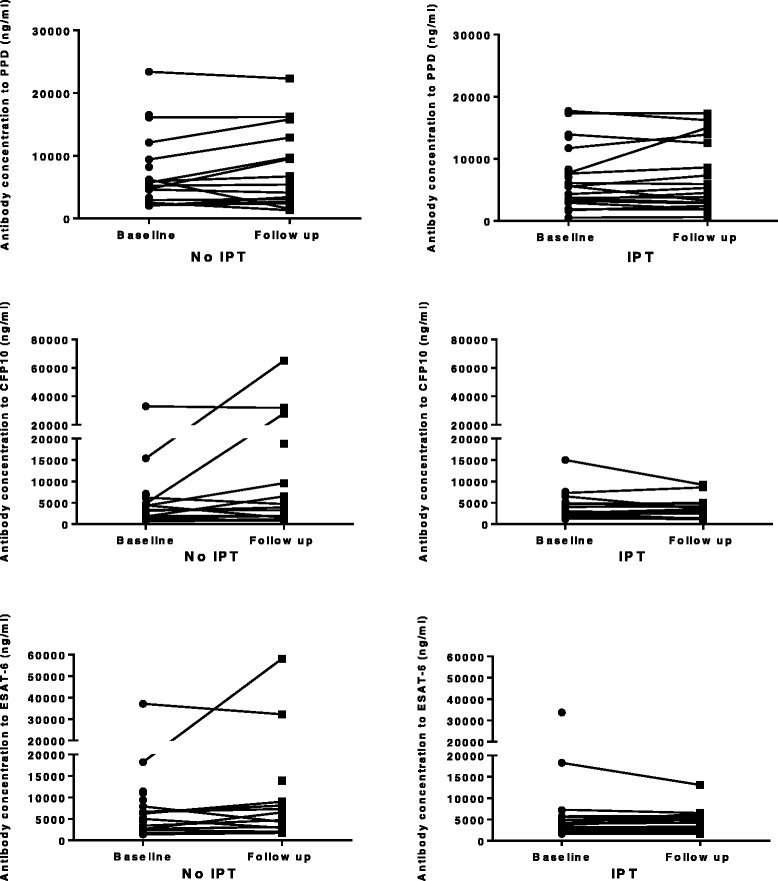Effect of isoniazid preventive therapy on immune responses to mycobacterium tuberculosis: an open label randomised, controlled, exploratory study
- PMID: 26493989
- PMCID: PMC4619204
- DOI: 10.1186/s12879-015-1201-8
Effect of isoniazid preventive therapy on immune responses to mycobacterium tuberculosis: an open label randomised, controlled, exploratory study
Abstract
Background: With the renewed emphasis to implement isoniazid preventive therapy (IPT) in Sub-Saharan Africa, we investigated the effect of IPT on immunological profiles among household contacts with latent tuberculosis.
Methods: Household contacts of confirmed tuberculosis patients were tested for latent tuberculosis using the QuantiFERON®-TB Gold In-Tube (QFN) assay and tuberculin skin test (TST). HIV negative contacts aged above 5 years, positive to both QFN and TST, were randomly assigned to IPT and monthly visits or monthly visits only. QFN culture supernatants from enrolment and six months' follow-up were analysed for M.tb-specific Th1, Th2, Th17, and regulatory cytokines by Luminex assay, and for M.tb-specific IgG antibody concentrations by ELISA. Effects of IPT were assessed as the net cytokine and antibody production at the end of six months.
Results: Sixteen percent of contacts investigated (47/291) were randomised to IPT (n = 24) or no IPT (n = 23). After adjusting for baseline cytokine or antibody responses, and for presence of a BCG scar, IPT (compared to no IPT) resulted in a relative decline in M.tb-specific production of IFN gamma (adjusted mean difference at the end of six months (bootstrap 95% confidence interval (CI), p-value) -1488.6 pg/ml ((-2682.5, -294.8), p = 0.01), and IL- 2 (-213.1 pg/ml (-419.2, -7.0), p = 0.04). A similar decline was found in anti-CFP-10 antibody levels (adjusted geometric mean ratio (bootstrap 95% CI), p-value) 0.58 ((0.35, 0.98), p = 0.04). We found no effect on M.tb-specific Th2 or regulatory or Th17 cytokine responses, or on antibody concentrations to PPD and ESAT-6.
Conclusions: IPT led to a decrease in Th1 cytokine production, and also in the anti CFP-10 antibody concentration. This could be secondary to a reduction in mycobacterial burden or as a possible direct effect of isoniazid induced T cell apoptosis, and may have implications for protective immunity following IPT in tuberculosis-endemic countries.
Trial registration: ISRCTN registry, ISRCTN15705625. Registered on 30(th) September 2015.
Figures



Similar articles
-
Tuberculin skin test reversion following isoniazid preventive therapy reflects diversity of immune response to primary Mycobacterium tuberculosis infection.PLoS One. 2014 May 5;9(5):e96613. doi: 10.1371/journal.pone.0096613. eCollection 2014. PLoS One. 2014. PMID: 24796677 Free PMC article.
-
Effect of isoniazid therapy for latent TB infection on QuantiFERON-TB gold in-tube responses in adults with positive tuberculin skin test results in a high TB incidence area: a controlled study.Chest. 2014 Mar 1;145(3):612-7. doi: 10.1378/chest.13-1232. Chest. 2014. PMID: 24135768 Free PMC article. Clinical Trial.
-
QuantiFERON-TB Gold In-Tube Test for Tuberculosis Prevention in HIV-Infected Patients.Jpn J Infect Dis. 2017 Sep 25;70(5):502-506. doi: 10.7883/yoken.JJID.2016.480. Epub 2017 Mar 28. Jpn J Infect Dis. 2017. PMID: 28367883
-
Tuberculosis preventive therapy: an underutilised strategy to reduce individual risk of TB and contribute to TB control.S Afr Med J. 2014 Apr 16;104(5):339-43. doi: 10.7196/samj.8290. S Afr Med J. 2014. PMID: 25212199 Review.
-
[Evolution of IGRA researches].Kekkaku. 2008 Sep;83(9):641-52. Kekkaku. 2008. PMID: 18979999 Review. Japanese.
Cited by
-
The Relationship Between Latent Tuberculosis Infection and Acute Myocardial Infarction.Clin Infect Dis. 2018 Mar 5;66(6):886-892. doi: 10.1093/cid/cix910. Clin Infect Dis. 2018. PMID: 29069328 Free PMC article.
-
Kaposi's sarcoma-associated herpesvirus seropositivity is associated with parasite infections in Ugandan fishing communities on Lake Victoria islands.PLoS Negl Trop Dis. 2019 Oct 16;13(10):e0007776. doi: 10.1371/journal.pntd.0007776. eCollection 2019 Oct. PLoS Negl Trop Dis. 2019. PMID: 31618208 Free PMC article.
-
Metformin Increases Cell Viability and Regulates Pro-Inflammatory Response to Mtb.Infect Drug Resist. 2023 Jun 7;16:3629-3638. doi: 10.2147/IDR.S401403. eCollection 2023. Infect Drug Resist. 2023. PMID: 37309381 Free PMC article.
-
Therapeutic Vaccines for Tuberculosis: An Overview.Front Immunol. 2022 Jun 24;13:878471. doi: 10.3389/fimmu.2022.878471. eCollection 2022. Front Immunol. 2022. PMID: 35812462 Free PMC article. Review.
-
Changes in IL-2 and IL-10 during Chronic Administration of Isoniazid, Nevirapine, and Paracetamol in Rats.Adv Pharmacol Sci. 2016;2016:3094783. doi: 10.1155/2016/3094783. Epub 2016 Nov 20. Adv Pharmacol Sci. 2016. PMID: 27990159 Free PMC article.
References
-
- Demissie A, Abebe M, Aseffa A, Rook G, Fletcher H, Zumla A, et al. Healthy individuals that control a latent infection with Mycobacterium tuberculosis express high levels of Th1 cytokines and the IL-4 antagonist IL-4delta2. J Immunol. 2004;172(11):6938–6943. doi: 10.4049/jimmunol.172.11.6938. - DOI - PubMed
Publication types
MeSH terms
Substances
Associated data
Grants and funding
LinkOut - more resources
Full Text Sources
Other Literature Sources
Miscellaneous

